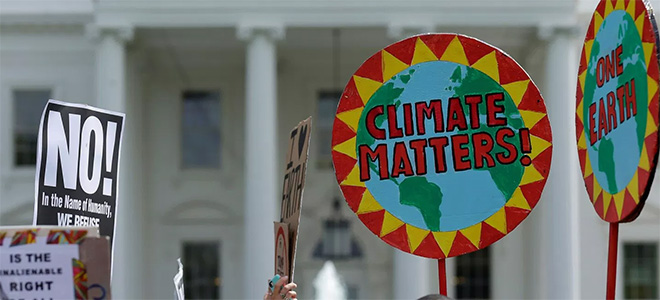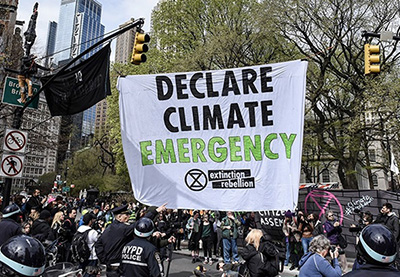Should We Hope for Power to Declare a National Climate Emergency?by Steve Vanderheiden |
|
Protesters carry signs during the Peoples Climate March at the White House in Washington. Photo: Joshua Roberts/CNS. |
|
In the wake of the president’s declaration of an emergency along the nation’s southern border, bypassing Congressional appropriations authority to fund his promised border wall, observers are of two minds about the powers this declaration invokes and the precedent it sets. If the declaration stands—and several challenges pending at the time of this post will decide its legal fate—it would significantly expand executive power and further limit the legislative and oversight powers of Congress. While 182 of the 195 GOP members opposed to a February 26 House Resolution may have signaled their support of the declaration by opposing the resolution, several members of the president’s party expressed concern. Rep. Jim Sensenbrenner (R-WI), for example, remarked that “it is imperative that no administration, Republican or Democratic, circumvent the will of Congress.” Sen Marco Rubio (R-FL), who has characterized opposition to Trump’s border wall as “irrational,” also expressed reservations, suggesting that “we have to be careful about endorsing broad uses of executive power” that could later be used by future presidents, since “tomorrow the national emergency might be climate change.” Those opposed to both a border wall and a further shift of legislative power to the president may nonetheless find this prospect of granting future presidents emergency powers to address climate change appealing. Rep. Ilhan Omar (D-MN), for example, called upon the next president to invoke emergency powers “to address the existential threat to all life on the planet posed by Climate Change” on “day 1” of their term. Democratic presidential candidates Bernie Sanders and Elizabeth Warren have also both expressed support for declaring a climate emergency. One can certainly understand this sentiment, given the urgency of climate change combined with the federal government’s apparent inability to respond to it through normal policy processes. The U.S. Congress has not only failed to pass any meaningful legislation to reduce national carbon emissions in the 27 years since it pledged to do so with the 1992 UN Framework Convention on Climate Change, but it appears unlikely to be able to do so at any point in the foreseeable future. Recent normalization of the filibuster in the Senate for ordinary legislation has created a formidable obstacle. Continued GOP opposition to any kind of policy action on climate change that has prevailed over recent decades means that 60 votes would need to be found among Democratic senators, which is exceedingly unlikely. Neither party has held a filibuster-proof majority since the 95th Congress ended 40 years ago, and increasing partisan polarization suggest bipartisan cooperation will continue to be elusive. With likely defections by Senators from fossil fuel states like Louisiana and West Virginia on any bill involving carbon pricing or other controls, prospects for a legislative path toward federal climate are slim. Until recently, the most promising path was through EPA regulation of carbon dioxide, which the Supreme Court upheld as within the agency’s statutory authority under the Clean Air Act in Massachusetts vs. EPA (2006). Acting through this authority the Obama administration EPA promulgated rules controlling carbon emissions from motor vehicles through increases to federal Corporate Average Fuel Economy (CAFE) standards and from power plants in its Clean Power Plan, along with its rule controlling methane releases from oil and gas operations. Using these unilateral executive powers to circumvent certain Congressional obstruction, these proposed actions offered what was regarded as a sufficiently credible U.S. commitment to climate change mitigation for participation in the 2016 Paris Agreement, which was carefully negotiated under the already-ratified 1992 UN Framework Convention on Climate Change so as to avoid certain refusal by the Senate to ratify the climate treaty. That path no longer looks promising. The Trump administration has withdrawn the U.S. from participation in the Paris Agreement and moved to roll back all three Obama rules controlling greenhouse gas emissions. Over the longer term, GOP control of the presidency and Senate has enabled longstanding conservative plans to pack the federal judiciary with opponents of environmental protection capable of hamstringing future legislative or executive efforts at meaningful mitigation. Ordinary unilateral powers of the presidency like executive orders can be easily undone, and administrative decision making within executive agencies is vulnerable to party turnover in the presidency as well as obstruction by the legislative and judicial branches.
Enter extraordinary executive powers, such as those available through declarations of national emergency. These promise to bypass legislative opposition as well as otherwise-applicable statutes, as with the waiver of 28 federal environmental laws to allow for construction of Trump’s border wall. While the full degree of executive discretion that the judiciary will allow in this border emergency declaration remains to be seen, emergency powers are also a powerful tool for circumventing judicial opposition. For many concerned about the closing policy window for U.S. action on climate change, a precedent that might allow some future president to invoke and mobilize broad unilateral powers on behalf of the climate change mitigation actions that have thus far remained elusive at the federal level is enticing. Tolerating a stunt like Trump’s use of this power to build his wall may be a small price to pay for what could be the country’s last and best chance to respond to a much more compelling emergency. What powers could be invoked through a future presidential declaration of a climate emergency? According to UC-Berkeley Law Professor Dan Farber, these powers could include the immediate and indefinite suspension of federal oil leases, significant restrictions on automobile and truck use to decrease greenhouse emissions, mobilization of federal financial support for renewable industry, and the sanctioning of “companies or countries trafficking in fossil fuels.” As Farber suggests, the judicial response to challenges against Trump’s declaration matters, as federal courts upholding his use of this power with the border emergency declaration would “be a sign that they’re not willing to apply any meaningful oversight to presidential actions.” Significant new powers to combat climate change could be granted to a future president if the declaration is allowed to stand, and none of these powers stand any chance of being granted by Congress. But should those concerned about an unfolding climate emergency thereby hope that emergency powers be allowed to stand in the current context, for the purpose of using them in a future one? This is not altogether clear, and indeed the use of emergency power and of the proper balance of power between the legislative branch and president have long been the subject of debate. |
|
|
|
At the U.S. Constitutional Convention in 1787, James Madison and Alexander Hamilton grappled over this question, with Madison urging that the legislative branch be granted more powers and Hamilton urging a stronger executive. In his Federalist #70, Hamilton claimed that “decision, activity, secrecy, and despatch will generally characterize the proceedings of one man in a much more eminent degree than the proceedings of any greater number,” allowing a unitary executive like the president to more effectively respond to national emergencies, like those presented by military threats. Madison, whose designs are reflected in the larger share of power vested in Congress through the Constitution’s Article I, argued that limits upon power were of greater importance, pointing to the role of electoral accountability of House members in his Federalist #57, who will by the requirement of biannual elections “be compelled to anticipate the moment when their power is to cease, when their exercise of it is to be reviewed, and when they must descend to the level from which they were raised; there forever to remain unless a faithful discharge of their trust shall have established their title to a renewal of it.” It has only been through several intervening national emergencies—the Civil War, the Great Depression and two world wars, and the Vietnam war in particular—that power has shifted from the legislative branch to the president, giving rise to what some lament as an “imperial presidency” in which Congress is often unable to provide the constitutional check that Madison insisted upon. With the increasing popularity of a national security discourse following the 2001 attacks upon the Pentagon and World Trade Centers, some advocates for taking state action on climate change urged an “environmental security” or “climate security” discursive frame for such actions. As explained by the influential Copenhagen School of security studies, invoking an existential threat could invoke broad emergency powers to address that threat, temporarily setting aside the normal constraints upon executive actions like Congressional or judicial oversight, statutory limits upon state power, and even individual rights. Through this process of securitization, which “claims a need for and right to treat [the threat] by extraordinary means” powers previously unavailable to effectively combat a climate emergency might become so if the issue could be credibly linked with a threat to national security. As with current interest in new presidential powers to declare a climate emergency, some advocated for securitizing new threats like climate change in the post-9/11 period of high salience for national security, but the authors cautioned against an uncritical invocation of emergency power, noting that “one has to weigh the always problematic side effects of applying a mind-set of security against the possible advantages of focus, attention, and mobilization.” |
|
 |
|
As environmental security scholar Dan Deudney points out, the treatment of climate change as “the moral equivalent of war” may motivate strong defensive actions and mobilize important powers to address a problem like climate change, but carries significant downside risks. Given that the traditional security focus is upon armed conflict and often involves an “us versus them” mindset, whereas effective climate action requires sustained international cooperation, it would be more accurate to say that “environmentalism is a threat to ‘national security’ mindsets and institutions” than it would be to claim that environmental change threatens national security.[1] A similar cautionary note might be sounded in regard to the more recent call for emergency powers to address climate change. As noted by Joseph Goffman, executive director of Harvard Law School’s Environmental and Energy Law Program, “climate change is going to require a significant reinvestment and reinventing of basic infrastructure that involves lots of players buying into the solution and sustaining that kind of effort over a long period of time,” requiring public buy-in and political coalition-building rather than the sort of powers that declarations of emergency make available. Consolidating new powers in the presidency to act on emergencies like climate change risks abuse of such power without the legislative and judicial checks that framers of the Constitution insisted upon and which have prevented past abuses, and provides only a temporary and limited set of powers in return. While climate change offers a much more compelling threat than does the claimed “emergency” at our southern border, it is not the kind of emergency for which these powers are designed, requiring sustained domestic and international cooperation over time along with a transformation of public attitudes and beliefs along with a transformation of our energy and transportation infrastructure. Such is not to dismiss the potential value of such emergency powers altogether, nor is it to identify any near-future basis for securing political support for the kind of social investment that Goffman identifies as needed. Rather, it is to temper some of the recent enthusiasm through which such powers have been suggested as unproblematically attractive or potentially sufficient as a top-down solution on their own. While it might be taken as evidence of the inadequacy of any set of governance institutions that they cannot generate meaningful policy responses to a problem like climate change, working within those flawed institutions while working to reduce their flaws offers more likely prospects for future climate actions than do hopes that they might be preempted or circumvented through emergency powers. [1] Daniel H. Deudney, “Environmental Security: A Critique,” from Contested Grounds: Security and Conflict in the New Environmental Politics ed. by Deudney and Richard A. Matthews (Albany: SUNY Press, 1999), 187-219. |
|
 Steve Vanderheiden Steve Vanderheidensteven.vanderheiden@colorado.edu CSTPR Core Faculty & Associate Professor of Political Science and Environmental Studies at University of Colorado Boulder |




